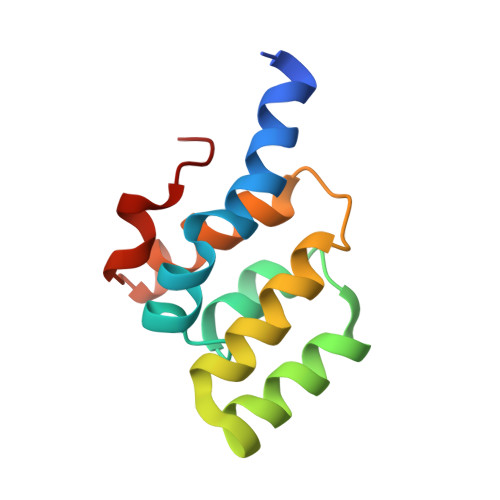Structure and Dynamics of the Second CARD of Human RIG-I Provide Mechanistic Insights into Regulation of RIG-I Activation.
Ferrage, F., Dutta, K., Nistal-Villan, E., Patel, J.R., Sanchez-Aparicio, M.T., De Ioannes, P., Buku, A., Aseguinolaza, G.G., Garcia-Sastre, A., Aggarwal, A.K.(2012) Structure 20: 2048-2061
- PubMed: 23063562
- DOI: https://doi.org/10.1016/j.str.2012.09.003
- Primary Citation of Related Structures:
2LWD, 2LWE - PubMed Abstract:
RIG-I is a cytosolic sensor of viral RNA, comprised of two N-terminal CARDs followed by helicase and C-terminal regulatory domains (helicase-CTD). Viral RNA binds to the helicase-CTD and "exposes" the CARDs for downstream signaling. The role of the second CARD (CARD2) is essential as RIG-I activation requires dephosphorylation of Thr170 followed by ubiquitination at Lys172. Here, we present the solution structure and dynamics of human RIG-I CARD2. Surprisingly, we find that Thr170 is mostly buried. Parallel studies on the phosphomimetic T170E mutant suggest that the loss of function upon Thr170 phosphorylation is likely associated with changes in the CARD1-CARD2 interface that may prevent Lys172 ubiquitination and/or binding to free K63-linked polyubiquitin. We also demonstrate a strong interaction between CARD2 and the helicase-CTD, and show that mutations at the interface result in constitutive activation of RIG-I. Collectively, our data suggests a close interplay between phosphorylation, ubiquitination, and activation of human RIG-I, all mediated by CARD2.
- Ecole Normale Supérieure, Département de Chimie, UMR 7203 CNRS-UPMC-ENS, 24, rue Lhomond, 75005 Paris, France. fabien.ferrage@ens.fr
Organizational Affiliation:
















